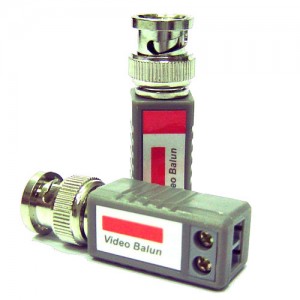 If you would rather use Cat5E instead of RG59 cable, it’s likely that somewhere along the way you will need a passive video balun. Security Camera King carries a full line of baluns both active and passive. Passive video baluns help prevent the degradation of the radio frequency signal over cable.
If you would rather use Cat5E instead of RG59 cable, it’s likely that somewhere along the way you will need a passive video balun. Security Camera King carries a full line of baluns both active and passive. Passive video baluns help prevent the degradation of the radio frequency signal over cable.
A balun is really a specific type of transformer that can convert electrical signals that are balance about ground (also known as differential) to signals that are unbalanced (single ended) and vice versa. The name “Balun” comes from two words, BAL(ance) and UN(balance).
For those of us that are not electrical engineers, another way to put it is that passive video baluns can boost signal strength and help your system make a transition to one type of cable to another. For example, most cable used in the digital video security industry is RG59 coaxial cable. This is an excellent cable for the job, however RG59 only has a working distance of about 600 feet before the signal starts to degrade causing poor video quality.
Using a passive video balun, the signal can be changed at the connection source from RG59 to CaT5E. This is done because Cat5E is less expensive for one thing, secondly it’s easy to pull when installing it, it’s generally less expensive than RG59, and a passive video balun and Cat5E can carry a signal further than RG59 cable, usually about 1,000 to 1,200 feet.
In addition, if you do use Cat5E cable instead or RG59 you will have multiple pairs of wires at your disposal. RG59 basically has a solid copper core wire insulated with plastic and then a metal shield (in essences the second wire) which is then covered by the cable cover (usually some type of plastic). A digital video camera uses both of those wires the copper core and the outer shield to transmit its signals.
However, by using a passive video balun with Cat5E cable you have access to 8 (4 pairs) of (usually) 22 gauge wire. This allows you to use just one Cat5E cable instead of 4 RG59 cables for 4 security cameras.
Many people would say they’ve never seen a balun before, but chances are they have. Some older model TVs came equipped with a cable TV type plug and no antenna connection. Usually, the RG59 type cable has 75 ohms of impedance. An antenna was often 300 ohms of impedance. An “adapter” often came with the TV with a male cable TV type plug on one end, and two screw connections on the other end to connect to an antenna. That adapter is actually a balun, and it’s used to balance the impedance differential between the TV outlet and the antenna.
Before going any further, now would be a good time to address the “passive” in passive video balun. Baluns may be passive or active. An active video balun is much like the passive video balun with one distinction: The active video balun requires power. Usually, most active baluns use 12 VDC, the same type of power that the digital video system uses for the cameras.
Active video baluns, depending on the type, etc. like the one used in our example above of the passive balun that got 1,000 – 1,200 foot range, would be capable of boosting the signal on Cat5E upwards to a length of up to 4,000 – 5,000 feet.
Security Camera King offers a wide variety of passive video baluns to suit your needs. Below is a partial list of our available baluns and a short description of each:
- – Product# BALUN-P. Passive video balun with BNC connector on one side and Cat5E connector (RJ45) on the other;
- – Product# SVU-PR8. 8 channel passive CCTV receiver hub with female BNC outputs.
- – Product# BALUN-V. Single channel passive video balun with video and power. This balun is not powered, it truly is passive. The power connection provided is for continuing your power supply past the balun by using one pair of wires from the Cat5E cable. Saves time so you don’t have to cable separate power supply wires.
This should give you a good idea of what passive video baluns are and what they do. If you have any additional questions please contact one of our security experts.











